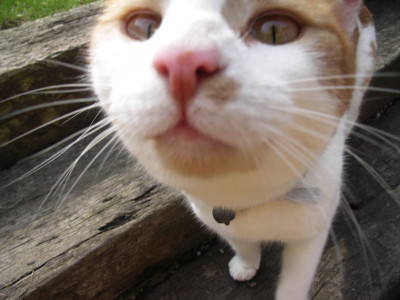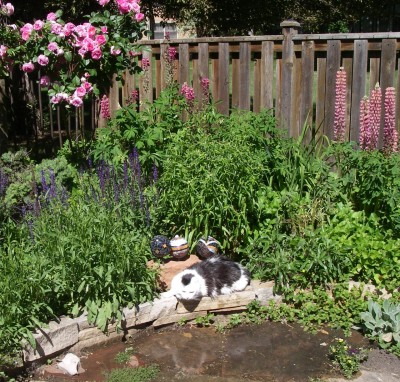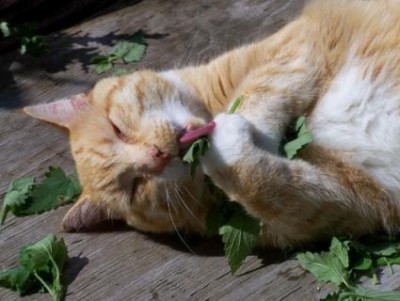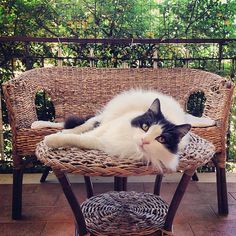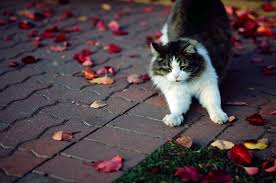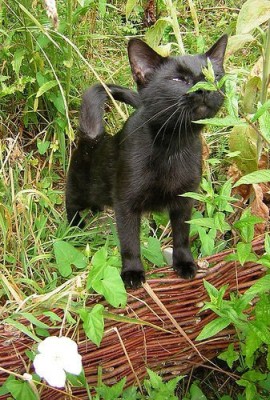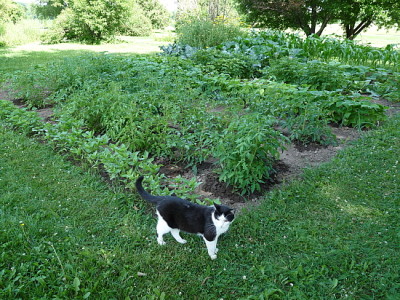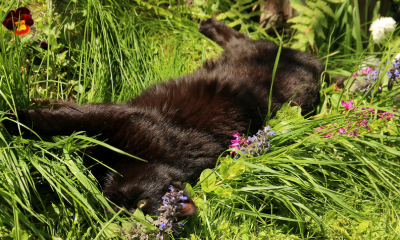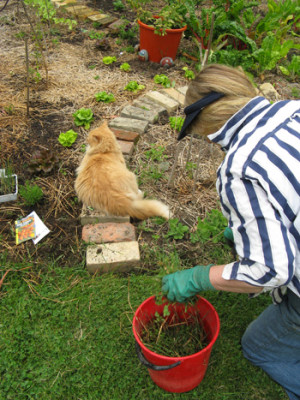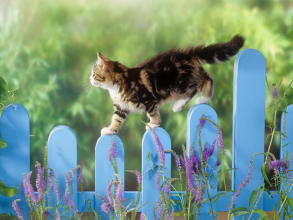
Your garden is a whole other world to your cats! It can be either a very boring or a very fascinating place for them, from where they can survey their territory and guard it as their own. The more complex the garden, the happier the cats are. They like places to sit in the sun and spots of shade, by bushes to lurk under or sniff around. Cats seek areas to explore, scratch and mark with their scent.
If you are afraid that your cat may find your garden boring, add some variety. Instead of long stretches of lawn, put in a hedge of lavender or geraniums, and add some great big pots to your paving. These areas will provide dampness and shade on hot days, allowing cats to have multiple options as to where they can relax next. Unlike humans who prefer to stay in one comfortable place, most cats like to have several spots for snoozing.
Cats also like gardens with lots of smells. Make your garden sniff-able! Grow hedges of lavender for your cat to sleep under, or plant cat thyme (Teucrium marum) for an attractive aroma. Cat thyme is irresistible for cats; they will roll in it or just sit there, drinking in the aroma. A word of warning however, cat thyme is only really fragrant in hot weather when the scented volatile oils evaporate. Certain cultivars are much more potent in scent than others. Some cats like catnip too, not for the scent, but because the young leaves are slightly hallucinogenic. Also, always check to see what plants your cat (and dog) might be allergic to before planning and planting.
Cats like to survey the world. It means they can safely keep an eye on their territory, observing intruders. Cats often like to fix themselves on windowsills, especially if there is a bush next to a wall that they can lurk behind. Garden furniture is irresistible to felines for sitting and sleeping on, or pretending to be human.
Paving is also excellent for cats. It helps wear down their claws, and offers a warm place to sleep during winter days and a cooler space when it is hotter. Plant herbs, like lawn thymes or ever-flowering alyssum, in the crevices between paving stones to add scent and beauty for yourself as well as your cat.
Leg Lifting and Squatting
You can try repellents (mothballs, eucalyptus or wintergreen oil on cotton wool) to discourage cats from using garden beds as toilets. I find that a spray of cloudy ammonia combined with chopped chilies soaked overnight (or a tablespoon of Tabasco sauce for every cup of ammonia) keeps cats away from garden walls and doors. Handle it with extreme care, as it is toxic and very irritating to hands, eyes and skin, as well as posing potential dangers to the foliage and your cat if overused.
Most pets are creatures of habit, so try to train your cat to use a certain area in the garden. Be sure to maintain a fresh spot for your cat. A soaker hose will remove tempting scents in undesirable areas.
Every Dropping Has a Silver Lining
Dig a very deep hole, insert each day’s droppings, next scoop in about a handful of soil to keep flies off or cover with a sheet of wood or metal. When the hole is nearly full, add more soil and plant a tree, shrub, or rose bush. Whenever you enjoy its lush bounty, thank your cat!
Wandering Cats
You can keep cats in, or out of certain areas, if you are prepared to go to enough trouble. A loose stretch of chicken wire (at least 30cm/one foot high) on top of your fence will stop cats from straying since structures that are not rigid make them nervous. Two or three taut wires angled inwards over your fence (a bit like fences around car yards) will also do the trick.
Digging and Scratching
Since cats are clean creatures by nature, they need loose dirt to cover their droppings. If the only patch of easily scratched earth in a sea of green turf is your dug garden bed, then that’s the place your cat will use. Cats are also not stupid. They will assume that you have seen their need and with your labor, care and understanding, created that spot just for them. Being cats though, they are very unlikely to think of thanking you!
Cover newly dug soil with bird netting, which you can find at all garden centers. Just drape it over the patch you wish to protect, or stretch it tightly between two pieces of wood to cover sandpits. The cats will get tangled if they try to scratch the area and learn to go elsewhere. Bird netting lasts for years and can be easily rolled up and stored in a shed until needed.
Give a little thought to your pets when you design your garden (and its furnishings) and you may find that most difficulties with cats in the garden will soon disappear.
Remember certain plants are highly toxic to cats, and dogs! Check out the ASPCA links below before you plant any flowers or plants to make sure your pet will be joyfully sniffing the flowers for hours, without any poisonous side effects.
For information on plants toxic to cats visit: www.aspca.org/Pet-care/poison-control/Plants?plant_toxicity=toxic-to-cats
For information on plants toxic to dogs visit: www.aspca.org/Pet-care/poison-control/Plants?plant_toxicity=toxic-to-dogs
For the Best that Pet Lifestyle and Animal Welfare has to offer follow Wendy and Lucky Diamond on Facebook, Twitter, and right here at AnimalFair.com!

